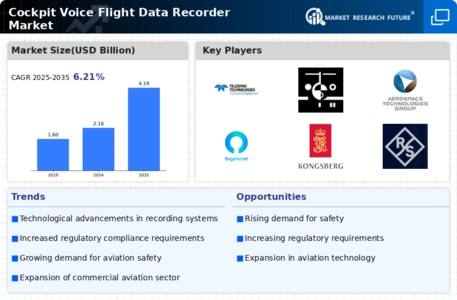Regulatory Compliance
Regulatory compliance plays a pivotal role in the Global Cockpit Voice Flight Data Recorder Market Industry. Governments and aviation regulatory bodies worldwide mandate the installation of cockpit voice recorders in commercial aircraft to ensure safety and accountability. For instance, the Federal Aviation Administration (FAA) and the European Union Aviation Safety Agency (EASA) have established stringent regulations regarding data recording and storage. As these regulations evolve, airlines are compelled to upgrade their existing systems, thus propelling market growth. The increasing focus on safety and compliance is projected to contribute significantly to the market's expansion, with a projected value of 2.16 USD Billion in 2024.
Growing Aviation Sector
The Global Cockpit Voice Flight Data Recorder Market Industry is poised for growth due to the expanding aviation sector. With the rise in air travel demand, airlines are investing in new aircraft equipped with advanced cockpit voice recorders. This trend is particularly evident in emerging markets, where increasing disposable incomes and urbanization are driving air travel. The International Air Transport Association (IATA) forecasts a steady increase in passenger numbers, which in turn fuels the need for enhanced safety measures, including reliable data recording systems. As the market evolves, it is anticipated that the industry will reach a valuation of 4.19 USD Billion by 2035.
Market Growth Projections
The Global Cockpit Voice Flight Data Recorder Market Industry is projected to experience robust growth over the next decade. With a market value of 2.16 USD Billion in 2024, it is anticipated to reach 4.19 USD Billion by 2035, reflecting a compound annual growth rate (CAGR) of 6.2% from 2025 to 2035. This growth trajectory is driven by various factors, including technological advancements, regulatory compliance, and an increasing focus on safety enhancements. As the aviation sector continues to evolve, the demand for reliable and sophisticated cockpit voice recorders is expected to rise, further solidifying the industry's position in the global market.
Technological Advancements
The Global Cockpit Voice Flight Data Recorder Market Industry is experiencing rapid technological advancements, particularly in data storage and retrieval systems. Innovations such as solid-state memory and enhanced audio recording capabilities are becoming increasingly prevalent. These advancements not only improve the reliability of data capture but also facilitate easier access to critical flight information. As a result, manufacturers are investing in research and development to integrate these technologies into new models. This trend is expected to drive market growth, as airlines and aviation authorities prioritize the adoption of advanced recording systems to enhance safety and operational efficiency.
Focus on Safety Enhancements
Safety enhancements remain a critical driver in the Global Cockpit Voice Flight Data Recorder Market Industry. Airlines and manufacturers are increasingly prioritizing systems that improve flight safety and incident investigation capabilities. The integration of advanced analytics and artificial intelligence into cockpit voice recorders allows for more comprehensive data analysis, which can lead to improved safety protocols. This focus on safety is not only driven by regulatory requirements but also by the industry's commitment to reducing accidents and enhancing operational efficiency. As a result, the market is expected to grow at a CAGR of 6.2% from 2025 to 2035, reflecting the ongoing emphasis on safety in aviation.
Market Expansion in Emerging Economies
The Global Cockpit Voice Flight Data Recorder Market Industry is witnessing significant expansion in emerging economies. Countries in Asia-Pacific and Latin America are investing heavily in their aviation infrastructure, leading to increased demand for cockpit voice recorders. Governments in these regions are implementing policies to enhance aviation safety, which includes mandating the installation of advanced recording systems in new aircraft. This trend is expected to drive market growth as airlines seek to comply with international safety standards. The increasing number of aircraft deliveries in these regions is likely to contribute to the overall market expansion, further solidifying the industry's global presence.




















Leave a Comment